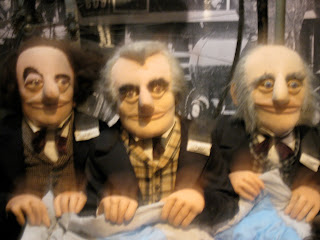The museum is operated by Parks Canada, and is an inexpensive place to visit.The site is comprised of exhibition spaces and the restored interior of Cartier's home. There aren't many historic homes in Montreal, and the Cartier house is the only restored Victorian interior on display to the public.
The exhibition section of the site leaves a lot to be desired. I couldn't help thinking about everything I would change. There were no introductory text panels to inform visitors about the exhibit's themes or raison d'etre. The first room simply has a sign that says "The railways, industrialization and political upheaval shpaed Montreal society in the 19th century." On display are coats, costumes, guns, and weird political figure dolls. One text panel tells about the fire department next to a graph with the rise in Montreal's population. It was all a bit disparate and nonsensical. The intention was probably to show the climate in the city when Cartier was in power, but there are other museums that do this better, in particular the Centre d'Histoire.

Moving on we come to a room with Cartier's personal and political history. Text panels are set up on the perimeter of the room. In the center is a round table with a glass dome in the center. Inside the dome are little wooden figures representing different stages of Cartier's life. Surrounding the table are all white male figures, presumably Cartier's cabinet or advisors. It was just all so bizare. 1980s museology?

I did learn things, albeit they may be things that I should have learned in high school. My mom gets tired of me saying I didn't learn much in high school, but in terms of Canadian history I think the Quebec curriculum is sorely lacking. Pretty much all I remember is about Louis Riel and the seigniorial system. I don't remember much of what I learned about Canada's formative years, so this museum offered a brief crash course in early Canadian history. It turns out that Cartier was responsible for the legislation that abolished the seignorial system in Montreal and for much of the city and country's modernization. The displays go through Cartier's life and accomplishments, but in a very didactic and not overly interesting way. At least the text is short and to the point.
The house part of the site is slightly more interesting. Each room has motion sensitive audio machines that play stories told my the house's staff. For example, the femme de menage tells us that Mr. Cartier rarely visited his wife's bedroom, and sometimes he would stay at a hotel even if he was in town. I'm not sure to what degree of accuracy the interior was designed to, and there are no text panels that go into detail about the decor. The dining room table is set up, including fake candles and fake food which was pretty gross, and kind of unecessary. What was really interesting was the list of all the foods they would consume at one meal. Between the first course, entrées, roasts, entrement, third course and sweets there must have been about 40 different dishes served. These kind of behind the scenes tidbits, the things that get left of textbooks, are part of what make a museum an interesting place to learn about the past. And the layers of information: textual, audio, and visual, add to the experience.
I think that there's potential here, but the displays are in desperate need of, well, being redone. On a scorching hot day it was a nice air-conditioned respite, but as a museum-experience it didn't thrill me. There were interesting sections but a lot missing.
15 down, 17 to go.

No comments:
Post a Comment